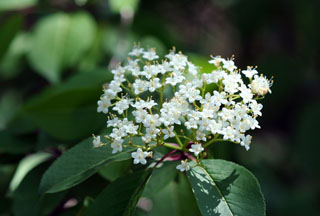BLACK HAW
|
 |
| File Size: 103 KB |
|
|
|
Viburnum prunifolium L.
|
| Photo by Craig Freeman |
| Height: Shrubs or trees, to 16 (32) feet |
| Family: Adoxaceae - Moschatel Family |
| Flowering Period: April, May |
|
| Also Called: | | Sweet haw. | | Trunks: | | Stems or trunk erect; branches unarmed; bark gray, fissures shallow, ridges blocky, flat; wood tan, hard. | | Twigs: | | Brown to grayish brown, rigid, glabrate; leaf scars crescent-shaped; buds reddish brown, ovoid, .12 to .28 inch, apex acute, scales glabrous or with few minute stellate hairs. | | Leaves: | | Deciduous, opposite, simple; petiole .2 to .6 inch, sparsely stellate-pubescent; blade broadly elliptic, 1.6 to 3.2 inch long, 1 to 1.8 inch wide, base cuneate, margins finely serrate to serrulate, apex acute to short-acuminate, lower surface light green to light yellowish green, sparsely stellate-pubescent initially, eventually glabrescent, upper surface dark green to dark yellowish green, glabrous or sparsely stellate-pubescent along midvein. | | Flowers: | | Inflorescences terminal on new growth, cymes, rounded, 2 to 4 inches wide, 80-150-flowered; peduncles 0 to .28 inch, glabrous or sparsely stellate-pubescent; pedicels .12 to .24 inch, glabrous or sparsely stellate-pubescent. Flowers bisexual, radially symmetric; hypanthium green, cylindric, .08 to .1 inch; sepals 5, connate proximally, lobes triangular; petals 5, connate proximally, corolla rotate, lobes white, ovate, .1 to .14 inch; stamens 5; pistil 1; style 1, ca. .05 inch; stigma capitate. | | Fruit: | | September-October; drupes, bluish black, ellipsoid to ovoid, slightly compressed, .4 to .5 inch long, .3 to .35 inch wide, glabrous, glaucous; stone 1, brown, ovate, strongly compressed, .3 to .43 inch long, .24 to .3 inch wide, rough. | | Habitat: | | Floodplain and upland forests and woodlands, stream banks, bases of bluffs. | | Distribution: | | East 1/6 of Kansas | | Origin: | | Native | | Uses: | | Several Native American tribes prepared a tonic using root bark or an infusion using bark, sometimes along with leaves, as a gynecological aid, oral aid, diaphoretic, anticonvulsive, or disease remedy (Moerman 1998). The fruits of Viburnum prunifolium are somewhat mealy but sweet (Stephens 1973); they were eaten raw or cooked by the Meskwaki tribe (Moerman 1998). |
|
| Black haw leaf |  | | 63 KB | | Johnson County, Kansas |
| | Black haw fruit |  | | 71 KB | | Johnson County, Kansas |
| | Black haw buds |  | | 40 KB | | Johnson County, Kansas |
| | Black haw buds |  | | 51 KB | | Johnson County, Kansas |
| | Black haw bark |  | | 144 KB | | Johnson County, Kansas |
| | Black haw leaves |  | | 81 KB | | Johnson County, Kansas |
| | Black haw leaves |  | | 70 KB | | Johnson County, Kansas |
| | | |
|
|
|